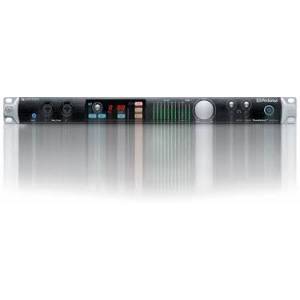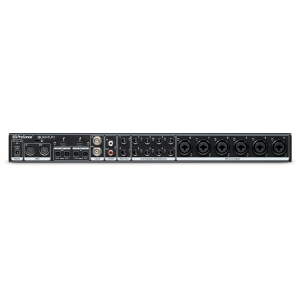PRESONUS QUANTUM
SCHEDA AUDIO
GRANDE DEFINIZIONE ED OTTIMA ESPANDIBILITÀ
L'interfaccia audio/MIDI PreSonus® Quantum audio/MIDI sfrutta con grande efficacia l'alta velocità dei bus Thunderbolt™ 2 bus e degli I/O ottici ADAT, riuscendo a fornire fino a 26 ingressi e 32 uscite con tempi di latenza bassissimi.
Eccellente qualità audio con registrazione e riproduzione 24-bit/192kHz, preampli XMAX automatizzabili e possibilità di espandere il sistema a seconda delle esigenze, rendono Quantum la scelta perfetta per una grande varietà di musicisti e produttori che cercano hardware di qualità professionale per le proprie realizzazioni.
CARATTERISTICHE TECNICHE:
GENERAL FEATURES
26x32 Thunderbolt 2 ultra-low-latency audio interface
PreSonus’ fastest interface; record direct to DAW (no DSP)
Stack up to four Quantum interfaces via Thunderbolt for a monster system
Talkback switch and internal Talkback microphone
Mute/Dim and Mono switches
Assignable output level control
10 8-segment LED meters (8 input, 2 output)
INTEGRATED SOFTWARE
Tight integration with included Studio One® Artist DAW software (Mac/Windows) for multitrack music production and studio command features
Wireless control over preamp levels from free UC Surface touch-control software (Mac®/Windows®/iPad®) and from free Studio One Remote for iPad
Compatible with most recording software for Mac and Windows
FLEXIBLE CONNECTIVITY
Simultaneous I/O up to 26 inputs/32 outputs (at 44.1 or 48 kHz)
2 front-panel combo microphone/instrument/line inputs
6 rear-panel combo microphone/line-level inputs
8 XMAX remote-controllable, Class A mic preamps with individually switched 48V phantom power
2 balanced ¼” TRS line-level main outputs
8 balanced ¼” TRS line-level outputs
Line outputs are DC coupled for sending control voltages for analog gear
ADAT Optical/Dual SMUX inputs/outputs: 16x16 channels at 44.1 or 48 kHz; 8x8 channels at 88.2 or 96 kHz
Stereo S/PDIF coaxial input and output
2 high-volume headphone outputs with dedicated volume controls
DIGITALIA
Thunderbolt 2 high-speed bus
24-bit resolution and up to 192 kHz sampling rate
Top-quality 120 dB A/D/A converters
BNC word clock input and output with low-jitter clocking
MIDI I/O on 5-pin DIN connectors
PHYSICAL
Road-rugged construction with all-metal chassis and metal knobs
1U rack-mountable
12 VDC external power supply (included)
SPECIFICHE TECNICHE:
MICROPHONE PREAMP
Type XLR Female (via Combo), Balanced
Maximum Input Level +10 dBu (Balanced, min. gain)
Gain Control Range 60 dB
Frequency Response 20 Hz to 20 kHz (±0.15 dB, unity gain, 48 kHz)
20 Hz to 40 kHz (±0.22 dB, unity gain, 96 kHz)
Dynamic Range > 110 dB (A-wtd, min. gain)
Total Harmonic Distortion < 0.005% (1 kHz, min. gain)
EIN < -131 dBu (max gain, 40?, 22 kHz BW, A-wtd)
Input Impedance 1.6 k?
Phantom Power +48V, > 8 mA per input
INSTRUMENT INPUTS
Type ¼” TS Female (via Combo), Unbalanced
Maximum Input Level +15 dBu (Unbalanced, min. gain)
Gain Control Range 60 dB
Frequency Response 20 Hz to 20 kHz (±0.2 dB, unity gain, 48 kHz)
20 Hz to 40 kHz (±0.6 dB, unity gain, 96 kHz)
Dynamic Range > 106 dB (A-wtd, min. gain)
Total Harmonic Distortion < 0.005% (1kHz, min. gain)
Input Impedance > 1 M?
LINE INPUTS
Type ¼” TRS Female (via Combo), Balanced
Maximum Input Level + 18 dBu (Balanced, min. gain)
Frequency Response 20 Hz to 20 kHz (±0.05 dB, unity gain, 48 kHz)
20 Hz to 40 kHz (±0.10 dB, unity gain, 96 kHz)
Dynamic Range > 118 dB (A-wtd, min. gain)
Total Harmonic Distortion < 0.005% (1 kHz, min. gain)
Input Impedance 10 k?
MAIN AND LINE OUTPUTS
Type ¼” TRS Female, impedance balanced
Maximum Output Level +18 dBu (Balanced)
Frequency Response 20 Hz to 20 kHz (±0.05 dB, unity gain, 48 kHz)
20 Hz to 40 kHz (±0.15 dB, unity gain, 96 kHz)
Dynamic Range > 118 dB (A-wtd)
Total Harmonic Distortion < 0.0035% (1 kHz, +4 dBu)
Output Impedance 51?
HEADPHONE OUTPUTS
Type ¼” TRS Female, Stereo, Unbalanced, x2
Maximum Output Level 175 mW/channel (56? load)
Frequency Response 20 Hz to 20 kHz (±0.5 dB, 48 kHz)
Dynamic Range > 110 dB (A-wtd)
Total Harmonic Distortion < 0.03% (1 kHz)
Headphone Impedance (working range) 16? to 300?
CROSSTALK
Input to Input < -110 dB
Output to Output < -115 dB
Input to Output < -120 dB
SIGNAL LEVEL LEDS
Clip -0.5 dBFS
Signal 1 -2 dBFS
Signal 2 -4 dBFS
Signal 3 -6 dBFS
Signal 4 -10 dBFS
Signal 5 -20 dBFS
Signal 6 -30 dBFS
Signal 7 -50 dBFS
DIGITAL AUDIO
Connection Type Thunderbolt 2
ADC Dynamic Range 120 dB (A-wtd)
DAC Dynamic Range 120 dB (A-wtd)
Bit Depth 24 bits
Internally Supported Sample Rates 44.1, 48, 88.2, 96, 176.4, 192 kHz
CLOCK
Jitter < 70 ps RMS (20 Hz – 20 kHz)
Jitter Attenuation > 60 dB (1 ns in => 1 ps out)
POWER
12 VDC, 5A, external power supply
PHYSICAL
Dimensions
Height 1.75" (44.45 mm)
Depth 7" (177.8 mm)
Width 19" (482.6 mm)
Weight 6 lbs (2.72 kg)
As a commitment to constant improvement, PreSonus® Audio Electronics, Inc., reserves the right to change any specification stated herein, at any time, without notification.
REQUISITI DI SISTEMA:
MAC
Mac® OS X 10.11.6 or later
Intel® Core™ i5 processor or faster
4 GB RAM (8 GB or more recommended)
WINDOWS
Windows® 10 64-bit
Intel Core i5 processor or faster
4 GB RAM (8 GB or more recommended)
MAC AND WINDOWS SYSTEMS
Thunderbolt 1 or 2 port (Computer’s motherboard must support Thunderbolt; Thunderbolt 3 systems supported with qualified Thunderbolt 2 adapter.)
Internet connection (required for registration and download of included software)
30 GB hard disk space (7200 RPM storage drive or faster highly recommended)
Monitor with 1366x768 resolution
IOS (UC SURFACE)
iOS 9.3 or later
iPad Pro, iPad Air 2, iPad Air, iPad mini 4, iPad mini with Retina display, iPad (4th generation), iPad mini, iPad (3rd generation), iPad 2?
ANDROID (QMIX-UC)
Android™ 5.0 (Lollipop) or later
Android smartphone or tablet
L'interfaccia audio/MIDI PreSonus® Quantum audio/MIDI sfrutta con grande efficacia l'alta velocità dei bus Thunderbolt™ 2 bus e degli I/O ottici ADAT, riuscendo a fornire fino a 26 ingressi e 32 uscite con tempi di latenza bassissimi.
Eccellente qualità audio con registrazione e riproduzione 24-bit/192kHz, preampli XMAX automatizzabili e possibilità di espandere il sistema a seconda delle esigenze, rendono Quantum la scelta perfetta per una grande varietà di musicisti e produttori che cercano hardware di qualità professionale per le proprie realizzazioni.
CARATTERISTICHE TECNICHE:
GENERAL FEATURES
26x32 Thunderbolt 2 ultra-low-latency audio interface
PreSonus’ fastest interface; record direct to DAW (no DSP)
Stack up to four Quantum interfaces via Thunderbolt for a monster system
Talkback switch and internal Talkback microphone
Mute/Dim and Mono switches
Assignable output level control
10 8-segment LED meters (8 input, 2 output)
INTEGRATED SOFTWARE
Tight integration with included Studio One® Artist DAW software (Mac/Windows) for multitrack music production and studio command features
Wireless control over preamp levels from free UC Surface touch-control software (Mac®/Windows®/iPad®) and from free Studio One Remote for iPad
Compatible with most recording software for Mac and Windows
FLEXIBLE CONNECTIVITY
Simultaneous I/O up to 26 inputs/32 outputs (at 44.1 or 48 kHz)
2 front-panel combo microphone/instrument/line inputs
6 rear-panel combo microphone/line-level inputs
8 XMAX remote-controllable, Class A mic preamps with individually switched 48V phantom power
2 balanced ¼” TRS line-level main outputs
8 balanced ¼” TRS line-level outputs
Line outputs are DC coupled for sending control voltages for analog gear
ADAT Optical/Dual SMUX inputs/outputs: 16x16 channels at 44.1 or 48 kHz; 8x8 channels at 88.2 or 96 kHz
Stereo S/PDIF coaxial input and output
2 high-volume headphone outputs with dedicated volume controls
DIGITALIA
Thunderbolt 2 high-speed bus
24-bit resolution and up to 192 kHz sampling rate
Top-quality 120 dB A/D/A converters
BNC word clock input and output with low-jitter clocking
MIDI I/O on 5-pin DIN connectors
PHYSICAL
Road-rugged construction with all-metal chassis and metal knobs
1U rack-mountable
12 VDC external power supply (included)
SPECIFICHE TECNICHE:
MICROPHONE PREAMP
Type XLR Female (via Combo), Balanced
Maximum Input Level +10 dBu (Balanced, min. gain)
Gain Control Range 60 dB
Frequency Response 20 Hz to 20 kHz (±0.15 dB, unity gain, 48 kHz)
20 Hz to 40 kHz (±0.22 dB, unity gain, 96 kHz)
Dynamic Range > 110 dB (A-wtd, min. gain)
Total Harmonic Distortion < 0.005% (1 kHz, min. gain)
EIN < -131 dBu (max gain, 40?, 22 kHz BW, A-wtd)
Input Impedance 1.6 k?
Phantom Power +48V, > 8 mA per input
INSTRUMENT INPUTS
Type ¼” TS Female (via Combo), Unbalanced
Maximum Input Level +15 dBu (Unbalanced, min. gain)
Gain Control Range 60 dB
Frequency Response 20 Hz to 20 kHz (±0.2 dB, unity gain, 48 kHz)
20 Hz to 40 kHz (±0.6 dB, unity gain, 96 kHz)
Dynamic Range > 106 dB (A-wtd, min. gain)
Total Harmonic Distortion < 0.005% (1kHz, min. gain)
Input Impedance > 1 M?
LINE INPUTS
Type ¼” TRS Female (via Combo), Balanced
Maximum Input Level + 18 dBu (Balanced, min. gain)
Frequency Response 20 Hz to 20 kHz (±0.05 dB, unity gain, 48 kHz)
20 Hz to 40 kHz (±0.10 dB, unity gain, 96 kHz)
Dynamic Range > 118 dB (A-wtd, min. gain)
Total Harmonic Distortion < 0.005% (1 kHz, min. gain)
Input Impedance 10 k?
MAIN AND LINE OUTPUTS
Type ¼” TRS Female, impedance balanced
Maximum Output Level +18 dBu (Balanced)
Frequency Response 20 Hz to 20 kHz (±0.05 dB, unity gain, 48 kHz)
20 Hz to 40 kHz (±0.15 dB, unity gain, 96 kHz)
Dynamic Range > 118 dB (A-wtd)
Total Harmonic Distortion < 0.0035% (1 kHz, +4 dBu)
Output Impedance 51?
HEADPHONE OUTPUTS
Type ¼” TRS Female, Stereo, Unbalanced, x2
Maximum Output Level 175 mW/channel (56? load)
Frequency Response 20 Hz to 20 kHz (±0.5 dB, 48 kHz)
Dynamic Range > 110 dB (A-wtd)
Total Harmonic Distortion < 0.03% (1 kHz)
Headphone Impedance (working range) 16? to 300?
CROSSTALK
Input to Input < -110 dB
Output to Output < -115 dB
Input to Output < -120 dB
SIGNAL LEVEL LEDS
Clip -0.5 dBFS
Signal 1 -2 dBFS
Signal 2 -4 dBFS
Signal 3 -6 dBFS
Signal 4 -10 dBFS
Signal 5 -20 dBFS
Signal 6 -30 dBFS
Signal 7 -50 dBFS
DIGITAL AUDIO
Connection Type Thunderbolt 2
ADC Dynamic Range 120 dB (A-wtd)
DAC Dynamic Range 120 dB (A-wtd)
Bit Depth 24 bits
Internally Supported Sample Rates 44.1, 48, 88.2, 96, 176.4, 192 kHz
CLOCK
Jitter < 70 ps RMS (20 Hz – 20 kHz)
Jitter Attenuation > 60 dB (1 ns in => 1 ps out)
POWER
12 VDC, 5A, external power supply
PHYSICAL
Dimensions
Height 1.75" (44.45 mm)
Depth 7" (177.8 mm)
Width 19" (482.6 mm)
Weight 6 lbs (2.72 kg)
As a commitment to constant improvement, PreSonus® Audio Electronics, Inc., reserves the right to change any specification stated herein, at any time, without notification.
REQUISITI DI SISTEMA:
MAC
Mac® OS X 10.11.6 or later
Intel® Core™ i5 processor or faster
4 GB RAM (8 GB or more recommended)
WINDOWS
Windows® 10 64-bit
Intel Core i5 processor or faster
4 GB RAM (8 GB or more recommended)
MAC AND WINDOWS SYSTEMS
Thunderbolt 1 or 2 port (Computer’s motherboard must support Thunderbolt; Thunderbolt 3 systems supported with qualified Thunderbolt 2 adapter.)
Internet connection (required for registration and download of included software)
30 GB hard disk space (7200 RPM storage drive or faster highly recommended)
Monitor with 1366x768 resolution
IOS (UC SURFACE)
iOS 9.3 or later
iPad Pro, iPad Air 2, iPad Air, iPad mini 4, iPad mini with Retina display, iPad (4th generation), iPad mini, iPad (3rd generation), iPad 2?
ANDROID (QMIX-UC)
Android™ 5.0 (Lollipop) or later
Android smartphone or tablet
Le immagini e le descrizioni dei prodotti riproducono nel modo più fedele le caratteristiche degli stessi. Possono peraltro sussistere errori o difformità sull’aspetto e nella descrizione dei beni e dei loro accessori. Le immagini e le descrizioni devono quindi intendersi come indicative. Farà fede la descrizione del prodotto contenuta nel modulo d’ordine.
PRESONUS
PRESONUS
PRESONUS
PRESONUS
PRESONUS
PRESONUS
PRESONUS












